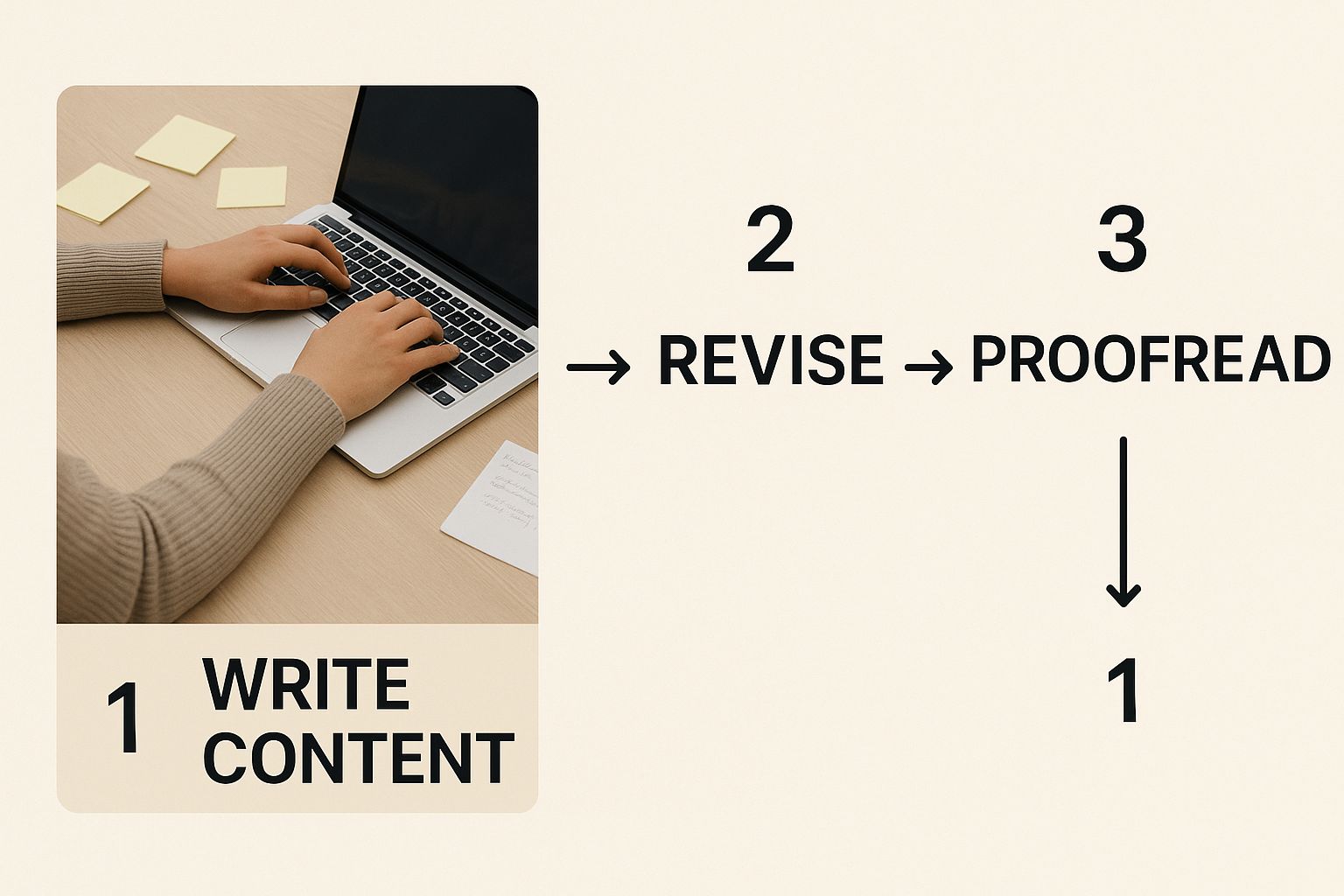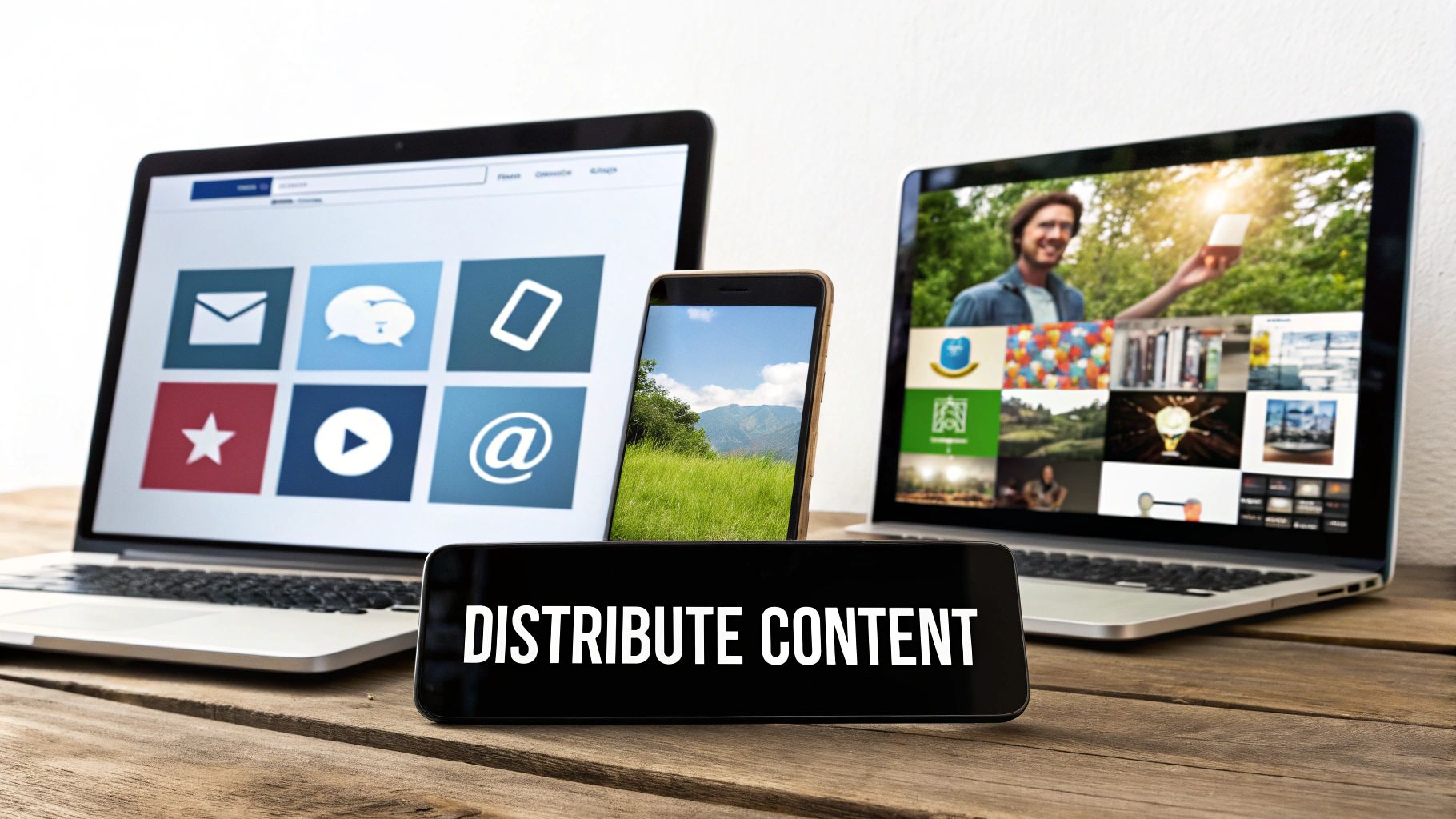
Build a Resilient Content Marketing Workflow
Tired of content chaos? Learn how to build a resilient content marketing workflow that saves time, boosts ROI, and delivers consistently powerful results.
Just hitting "publish" isn't a strategy. Frankly, it's a fast track to burnout and results that are all over the map. What separates the teams that truly grow from those just trying to keep their heads above water is a structured content marketing workflow. It’s the system that turns random acts of content into a predictable, growth-generating machine.
Moving from Content Chaos to Strategic Control

Trying to scale content without a workflow is like building a house without a blueprint. Sure, you might get a few walls up, but you can bet the foundation is shaky. This kind of chaotic process has real costs: blown deadlines, inconsistent brand messaging, and a whole lot of money wasted on content that never even finds its audience.
A documented content marketing workflow isn't just some boring administrative task to check off a list. It's your team's single most valuable asset for creating sustainable growth. It gives everyone a clear, repeatable roadmap to take a raw idea and turn it into a polished, published piece that actually performs.
The True Cost of a Disorganized Process
So, what does this chaos actually look like day-to-day? If you don't have a system, you're probably all too familiar with these pain points:
- Constant "Fire Drills": Every article or video becomes a last-minute scramble, tanking both quality and morale.
- Inconsistent Brand Voice: With different writers and creators doing their own thing, your brand starts to sound disconnected and confusing.
- Wasted Creative Cycles: Brilliant ideas get lost in endless email threads or forgotten in a notes app, never seeing the light of day.
- Zero Scalability: The only way to produce more content is to add more chaos and stress to the mix. It's simply not sustainable.
This friction isn't just an internal headache; it directly impacts your bottom line. And in today's landscape, you can't afford to be inefficient. A staggering 90% of businesses now have a formal content marketing strategy in place. What's more, 71% of marketers say content has become even more important in the last year alone.
The difference between a frantic, disorganized team and a high-performing one often comes down to their process. Here’s a quick look at the two realities:
Chaos vs. Control: The Impact of a Content Workflow
| Symptom of Chaos | Benefit of a Workflow | | :--- | :--- | | Missed deadlines and rushed work | Predictable timelines and consistent output | | Inconsistent brand voice and quality | A unified brand presence and high standards | | Lost ideas and duplicated efforts | Ideas are captured, prioritized, and executed | | Inability to scale content production | Scalable operations without sacrificing quality | | Low team morale and high stress | Empowered, autonomous, and focused teams | | Poor ROI on content investment | Better performance and measurable results |
A well-defined workflow transforms your entire operation, turning daily frustrations into strategic advantages.
A great workflow doesn’t restrict creativity; it liberates it. By standardizing the mundane parts of the process—approvals, formatting, scheduling—you free up your team's mental energy to focus on what truly matters: creating exceptional content.
Ultimately, a refined process empowers your team to scale output without sacrificing quality. Choosing the right marketing workflow software is a key step in this transition, providing the tools to manage this system effectively.
Laying the Strategic Foundation
The best workflows are built on a rock-solid strategy, not a fragile to-do list. Before you ever touch a headline or design a single graphic, this is the work that prevents wasted effort and makes sure every piece of content actually has a point. It’s the difference between shouting into the void and publishing for real impact.
A truly effective content workflow starts with knowing exactly who you're talking to. And I mean getting way beyond basic audience profiles. You need to develop detailed buyer personas that feel like real people. What are their daily headaches? What are their career goals? What specific, desperate questions are they typing into Google at 2 AM?
Think about it this way: a persona for ViewPrinter isn't just "a social media manager." It’s "Maria, a 28-year-old manager at a fast-growing e-commerce startup. She's completely overwhelmed by the demand for daily video content and can't keep a consistent brand look across all her platforms." That’s the kind of detail that guides every creative choice you make.
Aligning Keywords with Business Goals
Once you know Maria, you need to find out what she’s searching for. Good keyword research isn't about snagging a few high-volume terms; it's about deeply understanding user intent. Is she just looking for information, comparing different tools, or is she ready to pull out the company credit card?
Your aim here should be to build topic clusters—that is, groups of related content all pointing back to a central pillar page. This setup is a massive signal to search engines that you're an authority on the subject. For instance, you could have a pillar page on "Social Media Content Automation" supported by cluster posts like:
- "How to Schedule a Month of TikToks in Just One Hour"
- "The Best AI Tools for Generating Instagram Reels"
- "Finally, a Way to Measure ROI on Your Automated Social Campaigns"
This kind of strategic thinking bakes purpose and SEO authority into your content right from the get-go.
So many people make the mistake of chasing vanity keywords with huge search volumes. Don't do it. Instead, focus on long-tail keywords that reveal a specific problem you can solve. A user searching "how to create UGC video ads for fashion" is a far more qualified lead than someone just searching "video ads."
Mapping Content to Your Calendar
With your personas and topic clusters locked in, you can finally build a content calendar that serves your business goals. Please, don't just fill it with random ideas. Map your major themes or campaigns months in advance.
Got a big product launch coming in Q3? Your Q2 content should be building hype and educating the market. Is there a big seasonal trend your audience cares about? Plan a whole content series around it. This kind of foresight turns your calendar from a simple scheduling tool into a powerful strategic roadmap.
Setting Goals That Actually Matter
Finally, every single part of your workflow needs to be measurable. But it’s critical to track the right things. Sure, metrics like page views and likes are nice for the ego, but they don't always translate into business growth.
You need to define key performance indicators (KPIs) that connect directly to revenue. Instead of just tracking website traffic, start measuring:
- Engagement Rate: Are people actually interacting with your content in a meaningful way?
- Lead Generation: How many people signed up for a trial or downloaded your guide?
- Conversion Rate: What percentage of leads from that one blog post became paying customers?
Setting these kinds of realistic, business-focused KPIs holds your content accountable for what really matters: driving tangible results for the business.
Building Your AI-Powered Creation Engine
Okay, you've got your strategy locked in. Now comes the fun part: production. This is where your big ideas become the actual assets that fuel your campaigns. A modern content marketing workflow isn't just about ticking off tasks on a list; it’s about using AI to make the whole process faster and smarter.
Let's be clear: this isn't about firing your creative team and letting robots take over. It’s about giving them superpowers. AI tools are everywhere now, and marketers are catching on. A recent study shows a whopping 77.9% preference for platforms like ChatGPT to support their work.
But look closer at how they're using it. It’s not for writing entire articles from scratch. The real value is in helping humans do their best work:
- Outlining (71.7%)
- Brainstorming (68%)
- Editing (22.4%)
Think of AI as a creative partner that helps you smash through writer's block and get a solid, performance-driven structure in place from the very beginning. You can dig into the numbers yourself in the latest research on AI in content marketing.
From Keyword to Polished Draft
So, how does this look in the real world?
Imagine your team has pinpointed "UGC ad best practices" as a target keyword. Instead of spending hours digging through search results, an AI assistant can spit out a dozen different angles, headlines, and a detailed outline in seconds. It’s a massive head start.
From there, your writer steps in. They take that AI-generated skeleton and bring it to life with their own expertise, your brand’s unique voice, and real customer stories.
The workflow breaks down like this:
- Brainstorming: Fire up an AI with a prompt like, "Generate 10 blog post titles for 'UGC ad best practices' targeting e-commerce managers."
- Outlining: Once you have a winner, follow up with, "Create a detailed blog post outline for the title '[Your Chosen Title],' including H2s, H3s, and key talking points."
- Drafting: This is where the human magic happens. The writer fleshes out the outline, injecting personality, original insights, and brand-specific examples.
This image really captures that core moment of creation, where ideas finally hit the page.

This is the heart of any workflow—the act of writing itself.
Establishing a Single Source of Truth
Once the draft is ready for review, things can get messy. Fast. This is where a central hub like ViewPrinter becomes your best friend. It acts as the single source of truth, ending the chaos of tracking V4_final_final.docx or chasing down feedback buried in a dozen different email and Slack threads.
When your brand guidelines, feedback, and assets all live in one place, you eliminate friction. Your team spends less time hunting for the right logo or latest draft and more time creating.
Every comment, edit, and approval is logged in one transparent, easy-to-follow trail. A designer can grab the final, approved copy without ever leaving the platform, ensuring the visuals and text are perfectly aligned.
This kind of cohesion is what separates a clunky process from a highly efficient one. To see how all the pieces fit together, check out our full guide on building an effective content creation workflow. By using smart tools, you can turn a simple keyword into a polished, beautifully designed asset in record time.
Designing a Repeatable Promotion System

Let's be honest. Incredible content is completely worthless if no one ever sees it. The final, and arguably most critical, piece of your content marketing workflow is building an efficient, repeatable system for actually getting it out there.
Hitting "publish" isn't the finish line. It's the starting pistol.
A real promotion system moves you beyond just randomly sharing a link and hoping for the best. It's about a strategic push that guarantees your hard work lands in front of the right audience, every single time. Using a central hub like ViewPrinter, you can schedule and queue up all your promotional assets so they’re ready to go the moment a post is live.
No more last-minute scrambling. It means a new blog post is immediately supported by a coordinated wave of social posts, stories, and video clips—all rolling out on schedule.
Creating Your Promotion Checklist
To make this happen consistently, every piece of content needs a simple promotion plan. Think of it as a pre-flight checklist for your team. It’s not about adding busywork; it's about making success a habit.
Here’s what that checklist might look like for every new asset:
- Initial Social Blast: Schedule 5-7 unique posts for your core platforms (like Instagram, TikTok, and LinkedIn) to publish over the first week. Remember to tailor the message and format for each one.
- Email Newsletter Feature: Draft a short blurb for your next newsletter that highlights the new content and teases the value inside for your subscribers.
- Internal Amplification: Drop a link in your company's Slack or Teams channels. A quick note encouraging employees to share it with their own networks can work wonders.
- Targeted Outreach: Identify 3-5 key influencers or partners who would genuinely find the content useful and shoot them a quick, personalized note.
Maximizing ROI with Content Repurposing
The most efficient teams don't just create assets; they multiply them. This is where content repurposing comes in—the art of systematically breaking down one big piece of content into a bunch of smaller, derivative assets. It’s where your ROI really takes off.
Think of a comprehensive blog post not as a single asset, but as the raw material for an entire mini-campaign. It’s about working smarter, not just harder, to get the most value from your initial creative investment.
Take a single 2,000-word blog post. With a little creativity, you can transform it into:
- An Instagram carousel post detailing the key steps.
- A short video script for a TikTok or Reel.
- A handful of quote graphics for Twitter and LinkedIn.
- A downloadable PDF checklist you can use as a lead magnet.
This approach doesn't just fill your content calendar. It reinforces your core message across different platforms, meeting your audience where they already are. To really get this down to a science, check out our deep dive into building a powerful social media content workflow that can help automate this whole process.
Closing the Loop: How to Analyze and Optimize Your Workflow
Let's be honest, a content workflow that doesn't adapt is just a glorified to-do list. The real magic happens when you build a system that learns from its own results. This final piece of the puzzle—analysis and optimization—is what turns your content operation from a static plan into a smart, evolving machine.
This is more than just a quick peek at Google Analytics once a month. It's about systematically taking your performance data and plugging it right back into your strategy. Remember those KPIs you set up in the planning stage? Now's their time to shine. They're your roadmap for figuring out what’s working and what’s not.
Make Content Audits a Habit
The most effective way to turn raw data into smart decisions is through regular content audits. Think of it as a health check-up for your entire content library. It's your scheduled time to find the winners, pinpoint the losers, and spot fresh opportunities.
A simple audit really just comes down to a few core tasks:
- Find Your Top Performers: Dig into your analytics and find the articles, videos, or guides that are actually driving results—be it leads, sign-ups, or just high-quality traffic. Then, ask why. Was it the topic? The headline? The format? Your job is to decode the formula for success so you can repeat it.
- Identify the Underachievers: Next, find the content that's gathering dust. These pieces aren't failures; they're your biggest opportunities. Could a quick refresh with new stats, better images, or a focused SEO pass turn a dud into a stud? Absolutely.
- Spot the Gaps: When you're looking at everything you've created, you'll naturally start to see what's missing. What are your competitors ranking for that you aren't? What questions are your customers still asking? This is how you uncover entire new topic areas to own.
This isn't just a nice-to-have. A Marketing Charts study found that 50% of B2B marketers use research and analytics to decide what new content to create. Building this audit into your workflow makes it a reflex, not an afterthought.
The goal is to create a tight feedback loop where performance data directly informs future content strategy. An underperforming blog post isn't a failure; it’s a lesson that helps you write a better one next time.
Don't Forget to Audit the Process Itself
It’s not just your content that needs a check-up; your workflow does, too. Get your team together quarterly to talk about the process. Where are things getting stuck? What's taking way longer than it should? Are your tools still serving you well?
For instance, maybe you discover that the review and approval stage has become a major bottleneck, consistently throwing timelines off track. That's a huge insight. It tells you exactly where to focus your efforts—maybe you need clearer review guidelines, or perhaps you can use a tool like ViewPrinter to automate notifications and streamline the whole thing.
By constantly fine-tuning how you work, you do more than just produce better content. You make the entire process smoother and less stressful for everyone involved.
Answering Your Toughest Content Workflow Questions
Even with a perfect plan on paper, the real world has a way of throwing a wrench in the works. Building a great content marketing workflow always brings up a few tricky questions. Let's get into the nitty-gritty and solve the common friction points I see trip up even the best marketing teams.
These aren't just theories; they're practical answers to the problems that can stall your content engine.
What’s the “Right” Team Size for Our Workflow?
Honestly, there isn't one. The magic isn't in the headcount—it's in clearly defined roles. A solo creator can run a killer workflow, and a 20-person team can get completely bogged down. The secret is accountability.
A tiny team might have one person juggling everything from the initial idea to hitting "publish." A bigger operation will have specialists for each step. The workflow’s only job is to make sure every single person knows what they're responsible for.
- Solo Creator: You're the strategist, writer, designer, and promoter all in one. Your workflow is your personal sanity-saver.
- Small Team (2-4 people): Roles often overlap here. Maybe one person handles writing and editing, while another takes care of design and social media.
- Large Team (5+ people): Now you're talking specialists—dedicated pros for SEO, writing, editing, graphic design, video, and promotion.
Your workflow succeeds when every task has a clear owner, no matter if you're a team of one or twenty-one.
A huge mistake I see teams make is building a workflow that’s way too complicated for their size. Always start simple. A basic process that everyone actually follows is a hundred times better than a "perfect" one that gets ignored because it's a pain to use.
How Often Should We Bother Updating Our Workflow?
Think of your workflow as a living document, not a stone tablet. It has to grow and change with your team, your tools, and your goals. A good habit is to schedule a formal review every quarter.
But don't wait for a quarterly meeting if something is obviously broken. If one stage is constantly creating bottlenecks or confusion, fix it now.
For example, if your team groans every time they have to copy a draft from a Google Doc into your CMS because it's a manual, time-sucking mess, that's your sign. That's a problem to solve today, maybe by finding a better tool or a simple automation to handle the transfer.
Should We Use a Task-Based or Status-Based Workflow?
When you map out your process, you'll land on one of two main approaches. Knowing the difference helps you pick the right fit for your team's experience level.
A task-based workflow is super prescriptive, which is great for new or growing teams. A status-based one is more flexible, trusting experienced pros to know what to do.
| Workflow Type | Best For | What It Looks Like | | :--- | :--- | :--- | | Task-Based | Newer or growing teams | Each stage is a specific to-do item, like "Draft first version" or "Find 3 stock photos." It leaves very little room for error. | | Status-Based | Experienced teams | Each stage is simply a status, like "In Writing" or "Ready for Review." It gives your team more freedom and relies on their expertise. |
Most seasoned teams lean toward a status-based model because it's faster. But task-based workflows are fantastic for training new people and keeping everything consistent. You can even mix them—use detailed tasks for the tricky parts of your process and broad statuses for the simpler stages.
Ready to finally get rid of those bottlenecks and build a workflow that just works? ViewPrinter brings your entire process—from AI-powered creation and editing to scheduling and promotion—into one streamlined platform. Stop wasting time chasing down files and start creating content that gets results. Discover how ViewPrinter can transform your content marketing workflow today.